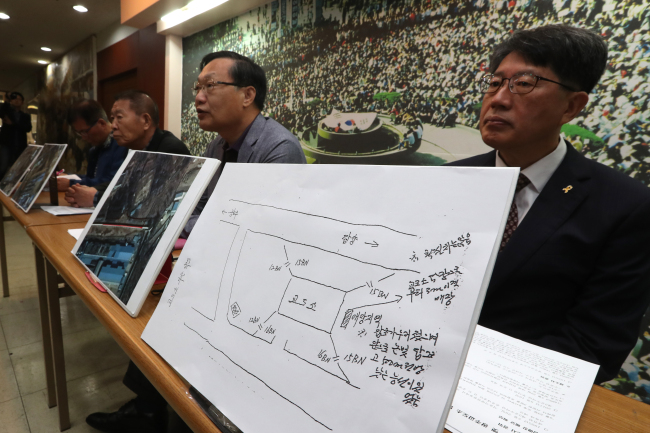A search for the remains of civilians killed during the 1980 Gwangju Democratization Movement is gaining momentum, with an excavation at a former prison site set to begin on Oct. 30.
The May 18 Memorial Foundation announced Monday that the restricted area where the old Gwangju Prison was located will be excavated to search for the remains of those still unaccounted for after the uprising, which was crushed by the military junta of Chun Doo-hwan.
 |
The May 18 Memorial Foundation members announce the plan to conduct an excavation investigation to find the missing bodies from the Gwangju Democratic Uprising in 1980, at a press conference held at the headquarters in Gwangju, South Jeolla Province on Monday. (Yonhap) |
“We will proceed with the excavation as carefully as possible and not damage even a scrap of thread,” the civic group said at a press briefing.
The May 18 Gwangju Democratization Movement was a pro-democracy movement in which more than 200,000 Gwangju citizens took to the streets against the military dictatorship of Chun, an army general who came to power through a military coup in late 1979. Hundreds were killed and wounded there as the regime raged the most violent crackdown in the nation’s modern history.
The protest was later officially recognized as a grassroots rebellion against the dictatorship. Since then, efforts have been made to find the missing, which the local government officially announced amounts to 82.
The investigation comes eight years after the last excavation in 2009. The government had run three excavation investigations from 2002 to 2009, after receiving some 64 reports from the public since 1998. But its dig-up of nine sites had failed to find any missing bodies.
About the secret burial of the bodies of the victims in the prison site, the military at the time had said 28 died there. But only 11 bodies have been collected.
The site had been selected following testimonies and reports that pointed to the area as a secret burial site of missing victims, it added.
A commander had testified to the prosecution last month that they had buried 12 bodies on May 23 that year and that three of the victims were killed as they were forcefully taken to the prison.
A noncommissioned officer and a citizen protestor who had also been in the jail reported on what they saw.
Based on the information, the excavation team will look into an around 117-meter stretch of land in the area and will use devices such as ground penetrating radar to detect bodies, the civic group explained.
If the team finds a body, it will run gene analysis tests to verify the identity and match them with the blood samples of bereaved families stored in the forensic studies department of Chonnam National University in the region.
During the press briefing, a special committee investigating the democratic uprising established at the Defense Ministry also announced that they had found evidence supporting that the government at the time had fabricated related facts about the incident.
“We have found out that the Chun administration had created committees and teams such as the ‘80 Committee’ in 1985 as a countermeasure structure after the incident,” the committee said. “The members constituting the committees were from government bodies such as the National Security Agency, closely aiding the leader.”
It explained that President Roh Tae-woo, who succeeded the administration in 1988, had also created similar government institutes. The special committee said it would look further into the allegations.
By Jo He-rim (
herim@heraldcorp.com)




![[Weekender] Korea's traditional sauce culture gains global recognition](http://res.heraldm.com/phpwas/restmb_idxmake.php?idx=644&simg=/content/image/2024/11/21/20241121050153_0.jpg)



